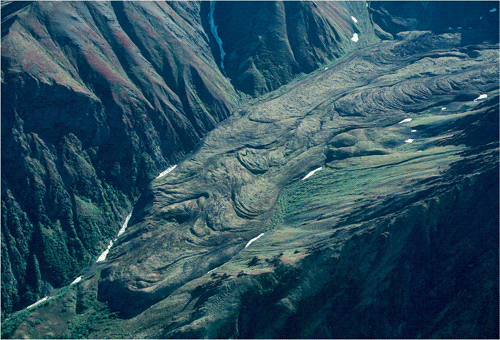
Rock glacier
Encyclopedia

Landform
A landform or physical feature in the earth sciences and geology sub-fields, comprises a geomorphological unit, and is largely defined by its surface form and location in the landscape, as part of the terrain, and as such, is typically an element of topography...
s of angular rock debris frozen in interstitial
Interstitial
An interstitial space or interstice is an empty space or gap between spaces full of structure or matter.In particular, interstitial may refer to:-Physical sciences:...
ice which may extend outward and downslope from talus
Scree
Scree, also called talus, is a term given to an accumulation of broken rock fragments at the base of crags, mountain cliffs, or valley shoulders. Landforms associated with these materials are sometimes called scree slopes or talus piles...
cones, glacier
Glacier
A glacier is a large persistent body of ice that forms where the accumulation of snow exceeds its ablation over many years, often centuries. At least 0.1 km² in area and 50 m thick, but often much larger, a glacier slowly deforms and flows due to stresses induced by its weight...
s or terminal moraine
Terminal moraine
A terminal moraine, also called end moraine, is a moraine that forms at the end of the glacier called the snout.Terminal moraines mark the maximum advance of the glacier. An end moraine is at the present boundary of the glacier....
s of glaciers. There are two types of rock glaciers: periglacial glaciers, or talus-derived glaciers, and glacial rock glaciers. Possible Martian
Mars
Mars is the fourth planet from the Sun in the Solar System. The planet is named after the Roman god of war, Mars. It is often described as the "Red Planet", as the iron oxide prevalent on its surface gives it a reddish appearance...
rock glacier features have been identified by the Mars Orbiter spacecraft.
Formation
Little is known about rock glacier formation.The two known factors that must be present in order to to create rock glaciers are low ice velocity and permafrost. Most glacial rock glaciers are created by the recession of debris covered glaciers. Glacial rock glaciers are often found in cirque basins where rocky debris falls off the steep sides and accumulates on ice glaciers. As the glaciers shrink,their composition changes as they become increasingly covered with debris. Eventually, the glacial ice is replaced by ice cored rocks. With the exception of ice-cored rock glaciers, rock glaciers are a periglacial process. This means that they are a nonglacial landform associated with cold climates, particularly with various aspects of frozen ground. Periglacial rock glaciers require permafrost instead of glacial ice in order to form. Instead, they are caused by continuous freezing occurring within a talus lobe.
Rock glaciers may also have a mass wasting
Mass wasting
Mass wasting, also known as slope movement or mass movement, is the geomorphic process by which soil, regolith, and rock move downslope under the force of gravity. Types of mass wasting include creep, slides, flows, topples, and falls, each with its own characteristic features, and taking place...
or landslide
Landslide
A landslide or landslip is a geological phenomenon which includes a wide range of ground movement, such as rockfalls, deep failure of slopes and shallow debris flows, which can occur in offshore, coastal and onshore environments...
origin, which does not require the presence of ice and suggests a sudden catastrophic origin with little subsequent movement.
Movement
Rock glaciers move downslope by deformation of the ice contained within them, causing their surface to resemble those of glaciers. Some rock glaciers can reach lengths of 3 km and can have terminal embankments of 60 m high. Blocks on the surface can be up to 8 m in diameter. Flow features on the surface of rock glaciers may develop from:- Deformation of the ice core.
- Movement of the debris cover along the debris-ice interface.
- Deformation from a period of glacial advance.
- Changes in the hydrologic balance.
Their growth and formation is subject to some debate, with three main theories:
- A permafrostPermafrostIn geology, permafrost, cryotic soil or permafrost soil is soil at or below the freezing point of water for two or more years. Ice is not always present, as may be in the case of nonporous bedrock, but it frequently occurs and it may be in amounts exceeding the potential hydraulic saturation of...
origin, which implies that the features are related to permafrost action rather than glacial action;
- A mass wastingMass wastingMass wasting, also known as slope movement or mass movement, is the geomorphic process by which soil, regolith, and rock move downslope under the force of gravity. Types of mass wasting include creep, slides, flows, topples, and falls, each with its own characteristic features, and taking place...
or landslideLandslideA landslide or landslip is a geological phenomenon which includes a wide range of ground movement, such as rockfalls, deep failure of slopes and shallow debris flows, which can occur in offshore, coastal and onshore environments...
origin which does not require the presence of ice and suggests a sudden catastrophic origin with little subsequent movement.
Rock glaciers may move or creep at a very slow rate in part dependent on the amount of ice present.

